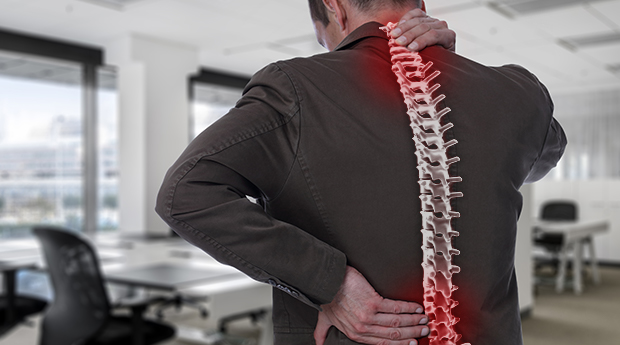Many of us were told as children “don’t slouch” and “sit up straight.” It turns out this was very good advice! Posture is how your body is positioned when you are sitting, standing, or lying down. This article will discuss why good posture is important, the health consequences of poor posture, and steps you can take to improve posture.
All of us want to have good posture, as it is an attractive feature. Unfortunately, very few people are committed to practicing daily rituals to improve their posture. This postural neglect can have serious consequences on our overall health.
Why is Good Posture Important?
Posture is the window into your spine. Your spine has a powerful relationship with your brain, spinal cord, and overall organ function.
The body was built with a curve in the spine to provide support and balance to the musculoskeletal system. This natural curve is essential for preventing deformation to bones, joints, muscles, and tendons.
The natural curve of the spine is reinforced by correct posture. Posture not only influences how you look but helps you breathe, improves concentration, supports vital organ function, and stimulates overall well-being.
Correct posture protects against disc degeneration that can lead to inflammatory conditions and disease. It is also critical for protecting the central nervous system.
What Is Subluxation?
We are in a modern age characterized by recurring activities that create stress on the supporting spinal column. Slouching, crossing legs, smartphone use, and incorrect ergonomic practices at home, school, and work cause poor posture.
These daily activities lead to the abnormal curvature of the spine and abnormal stress on the nervous system, which is known as subluxation. Subluxation interferes with nerve impulses and can manifest in numerous physical symptoms.
Examples of physical symptoms from subluxation include:
- Neuropathy
- Back pain or neck pain
- Chronic pain common in the hips, joints, lower back, pelvis, and knees
- Irritation of a specific area such as arm pain
- Weakened immune system
- Organ dysfunction
- Inability to move or exercise normally
- Dizziness and loss of balance
- Loss of bladder or bowel control
- Autoimmune conditions
- Headaches and migraines
- Fatigue
The spine is susceptible to numerous traumas, including birth, regular physical activities from exercise and sports, as well as accidental injury from car accidents and falls. Depending on the type of injury and which nerve pathways of the spine become disrupted, spinal subluxations can increase the risk for weakened immunity and lowered quality of life.
Loss of the spine’s natural curve inhibits normal physiological and nervous system functions. The ability to protect the brain stem and support the communication of nerve impulses throughout the body becomes suppressed.
In addition, physical limitations of the body marked by poor posture accelerate the aging process and increase inflammation. This is a result of the body’s inability to manage stress and tissue trauma appropriately.
The Arc of Life and Forward Head Posture
The natural curve of the neck is referred to as the “arc of life” by chiropractors and neurosurgeons. This arc should have a 40 to 45-degree curve. This curve helps protect the brain stem and the spinal canal. The spinal canal contains the spinal cord and nerves that travel to every region of the body.
As the arc of life reduces it becomes unstable and results in a forward head posture. Causes of forward head posture include:
- Looking down while typing or reading (which has become excessive with the use of smartphones)
- Sitting improperly with shoulders rounded and back hunched
- Driving with your head more than 2 inches away from the head rest
- Carrying a backpack or heavy purse over one shoulder
Forward head posture causes major stress on the musculoskeletal system. It can lead to many health issues.
Dangers of Forward Head Posture
There are numerous health problems associated with forward head posture. For every inch your head extends forward, your neck must support an additional 10 pounds of weight. Depending on the severity of the forward head shift, it can add up to 30 pounds of additional weight on the spinal discs, ligaments, and tendons.
As the head shifts forward, the thoracic spine moves. The weakening of the shoulder blades causes slouching and the appearance of hunchback. When you are slumped over, it triggers the descent downward of vital organs in the chest.
Your lungs need room to expand in your chest to work efficiently. When you are slouching, there is less room for your lungs to open. This results in a decrease in lung capacity and a reduced flow of oxygen into the diaphragm. Forward head posture keeps the body from effectively oxygenating cells.
A reduction in circulating oxygen in the body poses serious health threats. Oxygen is essential for survival because it maintains homeostatic functions including balancing hormones, supporting blood flow, protecting the body from chronic disease and cancer, fueling nutrient absorption, and protecting the health and healing of cells, tissues, and organs.
Other evidence supports that the correction of forward head posture:
1. Alleviates symptoms of respiratory complications such as asthma
2. Increases breathing and lung oxygenation essential for physical fitness
3. Strengthens abdominal muscles
4. Restores enlarged tonsils
5. Improves glandular function in the head and neck
3 Ways to Improve Your Posture by Correcting & Preventing Sublaxation and Forward Head Posture
#1: Chiropractic Care – Chiropractic adjustments can help compensate for postural abnormalities leading to an improvement in the health of the spine and the whole body. Research performed by Dr. Morningstar and Dr. Jockers (author of this article) found that chiropractic adjustments and rehabilitation exercises lead to the correction of forward head posture and cervical lordosis and restored pulmonary function.
Findings of the study also suggests that chiropractic care can improve the function of the autonomic nervous system by relieving tension that hinders the vital communication between the brain and body.
Corrective care chiropractors can identify abnormal features of the spine using x-rays, postural pictures, nerve scans, and various technologies. Chiropractic doctors can then develop a specific care plan to treat the individual’s concerns focusing on chiropractic adjustments and rehabilitative techniques.
#2: Lifestyle Practices – The first step to achieving good posture is being aware of your postural habits. Once you are aware of your poor postural habits, you can replace these habits with new healthy postural habits.
Four suggested lifestyle practices to reinforce good posture include:
a. Make sure the top of your computer screen is level with your eyes, about two feet away from your face
b. Carry a backpack squarely over both shoulders to balance the weight distribution
c. When carrying a purse or duffle bag, carry it diagonally across the torso
d. Have ample lower back support while sitting or lying for prolonged periods
#3: Exercises – Daily practice of the following exercises will help create new postural habits. Perform each of the following exercises twice a day for one minute. In 30 to 90 days you will notice improved posture and all its benefits.
a. The Eagle: To do this exercise, imagine opening your arms just like an eagle spreads its wings. Stretching your arms overhead will open the lungs and boost oxygen intake. The boost in oxygen stimulates tissue regeneration and increases blood flow.
Instructions for Exercise:
1. Stand with feet shoulder-width apart
2. Start with arms lowered and adjacent to sides
3. Simultaneously lift both arms above your head
4. Pause for a moment
5. Lower arms back down to sides in a slow and controlled movement
6. Repeat for 1 minute
b. The Hummingbird: This is a great exercise to remove the slouch from poor posture and to realign the head with the spine. The hummingbird strengthens the muscles between the shoulder blades, improves muscle fibers around the thoracic spinal column, opens pectoral muscles, and lifts the rib cage.
Instructions for Exercise:
1. Lift arms so that they are parallel to the floor
2. Bend elbows and face palms forward to form a 90-degree angle between the bicep and forearm
3. Rotate arms backwards in a circular movement while squeezing shoulder blades together
4. Repeat for 1 minute
c. The Trap Opener: The trapezius muscles stabilize the shoulder blades providing support for head and neck movement. Habitual forward head posture pulls and weakens the shoulder blades which consequently also relocates the ribcage. This exercise will release stress from the trapezius muscles and dispose of the so-called “monkey” on your back.
Instructions for Exercise:
1. Relax your shoulders
2. Drop your chin towards your chest
3. Roll head slightly to the right side
4. Use your right hand to massage trapezius muscles on the upper left side of the back
5. Repeat exercise for opposite side
6. Perform for 1 minute
d. The Butterfly: The butterfly is a great exercise to correct forward head posture. Performing this exercise regularly targets muscles in the neck and shoulders that cause chronic neck pain.
Instructions for Exercise:
1. Focus on lifting chest toward the ceiling
2. Bring your hands back against your head so that thumbs point down. *Optional: If reduced flexibility hinders your ability to lift arms and hands behind head, perform exercise standing flat against a wall. You can also align back of head against a seat.
3. Use about 10% of strength to push head backward while keeping head straight
4. Hold for approximately 10 seconds
5. Relax and repeat for 1 minute
e. The Chin Tuck: A contrasting exercise to the butterfly is the chin tuck. This exercise balances the opposite core muscles in the neck by strengthening the deep neck flexors. Performing the chin tuck helps balance your head and neck, reducing the occurrence of forward head shift.
Instructions for Exercise
1. Focus on lifting chest toward the ceiling
2. Maintain head position with ears over the neck
3. Place 1 hand on your forehead
4. Gently push forward with about 10% of strength (muscles in neck should contract and head should appear immobile)
5. Relax and repeat for 1 minute
Your Good Posture Summary
Good posture is essential for good health. How you look and feel is directly related to your posture.
Poor postural habits lead to illness, increase the risk for developing diseases in the body, and cause pain and discomfort.
Utilize the suggestions and exercises above to improve your posture. With improved posture, you will see dramatic benefits to your overall health and well-being.
Editor’s Note: This article was originally published in July 2017. It has been updated and republished in October 2023.
Article Summary
Posture is how your body is positioned when you are sitting, standing, or lying down. This article discusses why good posture is important, the health consequences of poor posture, and steps you can take to improve posture.
Posture not only influences how you look but helps you breathe, improves concentration, supports vital organ function, and stimulates overall well-being.
Daily habits and activities such as slouching, crossing legs, and smartphone use lead to the abnormal curvature of the spine and abnormal stress on the nervous system, which is known as subluxation. Subluxation interferes with nerve impulses and can result in numerous physical symptoms.
Forward head posture also causes problems. For every inch your head extends forward, your neck must support an additional 10 pounds of weight which can add up to 30 pounds of additional weight on the spinal discs, ligaments, and tendons.
3 ways to improve your posture include:
- chiropractic care
- lifestyle changes
- certain exercises (see the article for step-by-step instructions)




















When I was making pancakes for Shrove Tuesday at church, I stood in a certain position for a very long time and I ended up with a stiff neck.
excellent right on articles….have your book on cancer…many of which proven to work.